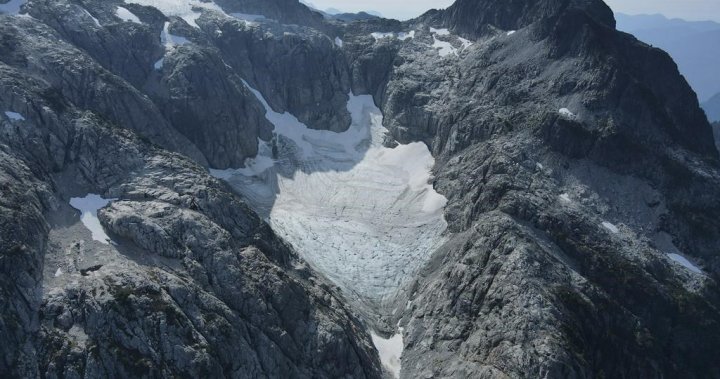On a mountain high above the residents of Metro Vancouver, hidden in a north-facing ravine, the region’s last remaining glacier is rapidly disappearing.
The Coquitlam Glacier survived for 4,000 to 5,000 years thanks to its sheltered location on the east side of the Coquitlam watershed.
However, scientists say it is among thousands across Canada shrinking faster than expected due to climate change, with consequences for everything from ecosystems and climate regulation to water supplies and tourism.
“It’s hanging in there, but it’s definitely spilling pretty quickly at this point,” said Peter Marshall, field hydrologist with Metro Vancouver Water Services.

Marshall and his team measured the glacier using laser and light technology, and he said the results were alarming.
Between 2015 and 2018, the glacier thinned by almost half a meter per year. Since then, the pace has risen to 2.25 meters per year. While the glacier’s disappearance was expected, the nearly fivefold acceleration was a surprise, especially since it coincided with years of heavy snow, he said.
“With the seasonal snowpack being above average, we thought maybe that would help slow it down, but I think the long, dry, hot summers we’ve had over the last five to seven years have really accelerated this change. “
Marshall said that in 20 to 30 years we will officially say that we have no glaciers in our region, adding that it could happen even sooner.
The Coquitlam Glacier is one of several in Western Canada being watched by experts as warm temperatures and soot from wildfires contribute to the melt.

Mark Ednie, a glaciologist with Natural Resources Canada based in Ottawa, said Canada’s glaciers have a special role to play in global climate regulation, as the country holds more square kilometers of glaciers than anywhere else in the world other than Antarctica or Greenland .
And those in British Columbia, Yukon and Alberta are notable for their rapid melting.
“Glaciers in western Canada and the northern United States are melting at one of the fastest rates in the world, so it’s quite, quite an eye-opener,” Ednie said.
Western Canada’s glaciers are an important water source and feed waterways such as the Bow River and North Saskatchewan River. As glaciers melt, water volume and quality will drop, with potentially large impacts for people living in those areas, he said.
Ednie compared glaciers to water reservoirs or water banks. Right now we’re pulling water that was stored in the 1800s, he said. “At some point soon,” however, the glacial melt will reach peak flow, then runoff to streams and rivers will decrease.
“This is something we have to plan for,” he said, adding that the effects of hydroelectricity will be felt in agriculture.
“Understanding what is happening and preparing for the future is my key message.”

Ednie is part of a team of just three people working on the National Glaciology Project, under the government’s climate change geoscience programme. They travel in helicopters with skis to visit the same 10 glaciers at least twice a year to measure them.
Like the Coquitlam Glacier, he saw some troubling results. In Alberta’s Banff National Park, the Peyto Glacier retreated nearly 200 horizontal meters in 2021. Over the past 10 years, the total retreat was only about 500 meters, he said.
“We’re really seeing the terminus of this glacier just absolutely disintegrate,” he said.
Brian Menounos, Canada Research Chair in Glacier Change, said he fell in love with glaciers straddling the Austrian Alps in his youth.
“It was spectacularly beautiful. I mean, ice in particular is, you know. I always tell students, it’s the earth’s most precious mineral,” says Menounos, who at the University of Northern VC

Glaciers play a critical role in keeping rivers and streams alive with water long after the seasonal snowpack has melted, with consequences for salmon and other species. They also play important roles in some indigenous cultures, and contribute to the economy as tourist attractions, he said.
And while Western Canada’s glaciers don’t add much to sea-level rise, the ice caps and ice fields in Canada’s eastern Arctic do, with global implications.
“This should be another crystal clear alarm that we need to act and decarbonize quickly,” Menounos said.
However, there are a host of additional challenges, he said. Last year it was the so-called heat dome followed by wildfires that dropped black soot onto glaciers’ white reflective surface, causing them to absorb more heat.
This year there was a fairly healthy snowpack, but the summer stretched into October, extending the warm season.
“This is a specific weather event. But, you know, if you add all these year-over-year variances together, it predicts a much more rapidly accelerating mass loss than we’ve traditionally seen,” he said.
“If I had to sum it up, glaciers can’t catch a break.”

Despite what we know about the vulnerability of glaciers, there is still much we don’t know, he said.
For example, the impact of wildfires and their role in light reflection has only recently been accepted as a significant contributor to melting, he said.
Menounos said investment in research is essential, as data contributes to modeling that can help us understand the impacts and design better responses. This will require action from various levels of government, he said.
“We really need to increase our ability to effectively monitor many of the different glaciers in BC and Alberta and other areas,” he said.





